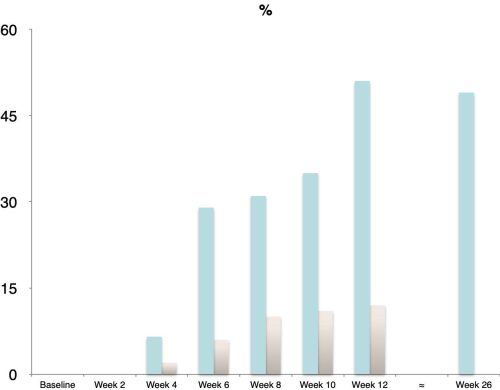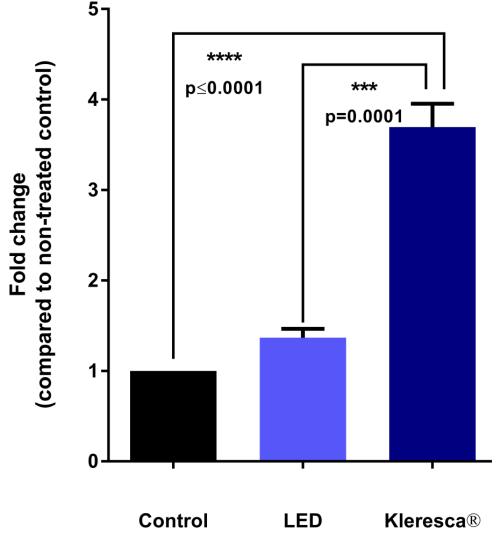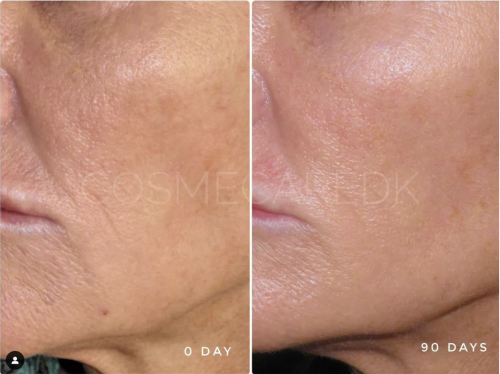
KLERESCA ACNE TREATMENT
The formulation contains a patented ‘Fluorophore’
(FluosineA)
with a specific energy profile which makes it effective on inflammatory acne and its consequences.
Powerful anti-inflammatory action
Bacteriostatic action
Stimulation of collagen production
ADVANTAGES
Reduces active lesions and improves scarring at the same time.
Results last for at least one year.
Can be used as monotherapy or in combination therapy.
TREATMENT PROTOCOL

Protocol
• 1 stacked sessions per week for 3/6 weeks
(6-12 treatments).
• 2 single sessions per week for 3/6 weeks
(6-12 treatments).
Maintenance
2 sessions every 2/4 months
Kleresca needs to be activated by a Blue LED Light with the following characteristics:
• Wavelengths: from 440 to 460 nm
• Fluence: ≈ 30 -39 J/cm²
• 9 minutes
MONOTHERAPY EFFICACY
90 IGA3 & IGA4 PATIENTS: 12 KAT SESSIONS*
• 89% respond positively to the treatment
• 52% improve≥2 IGA grades
• 33% obtain clear skin or almost clear skin(≈ IGA 0)
• Improvement≥2 IGA grades maintained in 92% of participants
• *2 individual sessions per week for 6 weeks
Jalili, A. 2018. Chromophore gel-assisted phototherapy. A novel and promising photobiomodulation therapy for facial inflammatory skin diseases and skin aging. J Ästhet Chir. 2018.
Nikolis, A.et al. An extension of a multicenter, randomized, split-face clinical trial evaluating the efficacy and safety of chromophore gel-assisted blue light phototherapy for the treatment of acne. Int. J. Dermatol. 2017
Antoniou, C.et al. A multicenter, randomized, split-face clinical trial evaluating the efficacy and safety of chromophore gel-assisted blue light phototherapy for the treatment of acne. 2016; Int J Dermatol, 2016, 55; 1321 –1328
Russo, A. et al., 2021. Fluorescent Light Energy combined with systemic isotretinoin: a 52-week follow-up evaluating efficacy and safety in treatment of moderate-severe acne

initial trial
Percentage of patients with improvement of ≥ 2 IGA grades from baseline to week 12
COMBINATION WITH SYSTEMIC TREATMENTS: EFFICACY

Russo, A. et al., 2021. Fluorescent Light Energy combined with systemic isotretinoin: a 52-week follow-up evaluating efficacy and safety in treatment of moderate-severe acne
FEMALE PATIENT WITH SEVERE ACNE

A 21-year-old female patient from Canada. She never suffered from acne before but began to develop nodulocystic acne.
Patient was treated twice a week for 6 weeks and got a single booster at week 33.
She received extremely good results with Kleresca® Acne Treatment and the good results and skin quality maintained for more than a year.
KLERESCA ACNE TREATMENT

MALE PATIENT WITH MODERATE ACNE

Male patient from Canada in his late twenties. He suffered from nodulocystic acne and got Kleresca® Acne Treatment twice a week for 6 weeks.
He obtained good results and his skin kept improving over time, showing no pimples and an improved skin texture more than one year after the treatment.
FEMALE PATIENT WITH MODERATE ACNE

Patient in her mid-twenties who suffered from nodulocystic acne. She received the Kleresca® Acne Treatment twice per week for 6 weeks and her skin improved dramatically. Her overall skin quality has visibly improved and she has maintained good results one year after completing the treatment
FEMALE PATIENT WITH SEVERE ACNE

Female patient who suffered from post-pregnancy acne. She received the treatment twice per week for 6 weeks and her nodulocystic acne improved extremely fast. By week 22 her over all skin quality and acne scars got a great improvement.
FEMALE PATIENT WITH SEVERE ACNE

Norwegian patient with nodulocystic acne mainly on the chin and mandibular area. She tried different over-the-counter treatments, cleansers and cosmetics, but acne
persisted. She tried Kleresca® Acne Treatment, a total of 12 treatments, twice per week. She already saw an improvement at week 6 , and after a small flare-up at week 12, her skin
continued improving during the following weeks. After 6 months, her skin looks clean, without acne and without inflammation. The same good resultscontinued1 year after.
MALE PATIENT WITH SEVERE ACNE

Young patient with acne and acne scars who decided to try Kleresca® Acne Treatment. A marked reduction of his cysts, papules and pustules, as well as an overall improvement in skin texture was already present at the end of treatment.
The results continued to improve over time, as we can appreciate at week 16, where the acne lesions, as well as the redness and the acne scars, have been visibly reduced.
FEMALE PATIENT WITH SEVERE ACNE

Patient in her twenties with severe acne. She got the Kleresca® Acne Treatment, twice a week during a 6 week period, with total of 12 sessions.
After she finished the treatment, her skin continued improving during the following weeks. At week 20, her skin looks much clearer, with a marked reduction of the inflammation and acne lesions as well as a healthier look.
FEMALE PATIENT WITH SEVERE CONGLOBATA ACNE

14-year old girl who has suffered with acne conglobate from the age of 9. Presented extensive papules, severe nodules and cystic lesions, affecting the cheeks and chin.
Previous treatment with topical isotretinoin was ineffective and patient was not a candidate for systemic isotretinoin since she was a professional handball player.
Patient treated twice a week for 6 weeks with Kleresca® Acne Treatment.
ACNEIFORM ERUPTION INDUCED BY ERLOTINIB

49-year-old patient. She developed an acneiform eruption induced by erlotinib, the cancer medication she was taking at that time.
She first was treated with topicals but without good results. The acne eruption evolved and spread to the entire face. She tried Kleresca® Acne Treatment, twice a week for 6 weeks, and withinonly3 weeks, the eruption was visibly reduced which notably improved her quality of life.
FEMALE PATIENT WITH SEVERE BACK ACNE

16-year-old female patient from Germany suffering from severe back acne. She received a total of 12 sessions of Kleresca® Acne Treatment, twice a week for six weeks. 6 months after the treatment was finalised, she presented a very smooth skin on her back, with a clear reduction of papules and pustules as well as inflammation..
FEMALE PATIENT WITH SEVERE ACNE

20-year-old female with IGA 4 acne, previously undergoing topical therapy with no effect. Treated with Kleresca® Acne Treatment + isotretinoin.
MALE PATIENT WITH SEVERE ACNE

An 18-year-old male with IGA 4 acne, previously treated with topical tetracycline with no effect and isotretinoin that was discontinued due to elevated creatine phosphokinase levels, and therefore not eligible for the standard dose of isotretinoin. Treated with FLE + isotretinoin.
18-year-old male with baseline acne severity of IGA 4, previously undergoing topical tetracycline without effect. Treated with FLE + isotretinoin
MALE PATIENT WITH SEVERE ACNE

18-year-old male with baseline acne severity of IGA 4, previously undergoing topical tetracycline without effect. Treated with FLE + isotretinoin
MALE PATIENT WITH MODERATE-SEVERE ACNE

18-year-old male with baseline acne severity of IGA 4, previously treated with topical tetracycline without effect and discontinued isotretinoin due to elevated levels of creatine phosphokinase, and thereby not eligible to standard dose of isotretinoin. Treated with FLE + isotretinoin
Prescription Chart

- Protocol consisting of 2 double sessions per week (= 4 sessions per week) appears to be the most efficacious for a quick control of inflammation. However, it can be switched to 1 double session per week based on patient availability.
- Illustrative: to be determined based on evolution.
- General recommendation is to stop isotretinoin when the patient has had a clear skin for several months.
ADVERSE EVENTS AND CONTRAINDICATIONS
HIGH LEVEL OF SAFETY AND TO LERABILITY
• No serious adverse events reported.
• No adverse events led to discontinuation of treatment.
• Events were transient and did not require medical attention.
CONTRAINDICATIONS
• Patients with conditions (e.g. porphyria) or taking drugs or substances (e.g. some antibiotics) susceptible to produce photosensitivity.
• Patients with known skin hypersensitivity.
Nikolis, A. et al. An extension of a multicenter, randomized, split-face clinical trial evaluating the efficacy and safety of chromophore gel-assisted blue light phototherapy for the treatment of acne. Int. J. Dermatol. 2017
Antoniou, C.et al. A multicenter, randomized, split-face clinical trial evaluating the efficacy and safety of chromophore gel-assisted blue light phototherapy for the treatment of acne. 2016; Int J Dermatol, 2016, 55; 1321 –1328
KLERESCA ROSACEA TREATMENT
The formulation contains a patented ‘Fluorophore’
(FLUOSINE R)
with a specific energy profile which makes it effective against the signs and symptoms of rosacea subtypes 1 and 2.
Powerful anti-inflammatory action
Stimulation of angiogenesis
Fast recovery
ADVANTAGES
Reduces flushing and burning or stinging sensations.
Treats redness, papules, and pustules; improves the appearance of microcapillaries.
Fast results from the very first sessions.
TREATMENT PROTOCOL

Protocol
1 stacked sessions per week for 3 weeks ( 6 treatments).
1 session per week for 6 weeks (6 treatments).
Maintenance
2 sessions when signs reappear.
Kleresca needs to be activated by a blue LED light with the following characteristics:
• Wavelengths: from 440 to 460 nm
• Fluence: ≈ 30 -39 J/cm²
• 9 minutes
IMPROVEMENT OF MICROVASCULARISATION


MODULATION OF ANGIOGENESIS
Formation of new blood vessels following treatment with Kleresca Rosacea in 4 different situations:


REDUCTION OF ROSACEA SYMPTOMS
Graphics show a clear reduction of inflammation in patients suffering from rosacea type I, II, and III after being treated with Kleresca®.

Sannino etal, Fluorescent Light Energy: Treating rosacea subtypes1, 2 and 3; Clin Case Rep.2018;1-6.
REDUCTION OF ROSACEA SYMPTOMS
The graphic shows a reduction in the intensity of the main rosacea symptoms in patients suffering from rosacea type I and II.

Intensity level of the main signs and symptoms of rosacea experienced by the treated patients, before and after the treatment.
Wade etal, Facial Erythema, Improves Signs and Symptoms of Rosacea, and Increases Patient Satisfaction; J Clin Aesthet Dermatol. 2021;14(7):16-21.
KLERESCA ROSACEA TREATMENT
Marked reduction of inflammation

Braun & Gerber. International Journal of Dermatology2017, 56, 1457-1517. © 2017 The International Society of Dermatology
4 sessions, once a week for 4 weeks

4 sessions, once a week for 4 weeks

3 sessions, once a week for 3 weeks

3 sessions, once a week for 3 weeks

KLERESCA SKIN REJUVENATION
The formulation contains a patented fluorophore
(FluosineS)
with a specific energy profile which carries out a global antiaging action.
Global cutaneous rejuvenation.
Skin structure stimulation.
Stimulation of collagen production up to 400%.
ADVANTAGES
Premium medical antiaging treatment.
Improves firmness by providing a plumping effect.
Improves skin quality, wrinkles, and pore size.
Preventive and corrective action: can be used at any age.
TREATMENT PROTOCOL

Protocol
1 session (9 minutes) per week for 6 weeks (6 treatments = 1 box).
Maintenance
1 Individual session or a full 6-treatment cycle whenever the patient feels like it.
KlerescaSkin rejuvenation needs to be activated by a blue LED light:
• Wavelengths: from 415 to 470 nm
• Fluence: 15 –39 J/cm²
• 9 minutes
PROVEN EFFICACY
In-vitro test on cell cultures receiving FLUOSINE S and Kleresca Light vs. LED lamp mimicking its spectrum:

With the LED light as a control, the treatment allows an increase of approximately 400% in collagen production.
Nikolis, A., et al . A randomized, placebo-controlled, single-blinded, split-faced clinical trial evaluating the efficacy and safety of KLOX-001 gel formulation with KLOX light-emitting diode light on facial rejuvenation. Clinical, Cosmetic and Investigational Dermatology, 2016; 9, 115–25.
In-vivo test on skin biopsies receiving FLUOSINE Sand Kleresca Light:

Gömöri’s Trichrome is a dye used on muscle tissue to stain the collagen present in the biopsy.
There is a visible increase in the amount of collagen (in blue) at 12 weeks after treatment.
Edge, D. Et al. Fluorescent Light Energy: the future for treating inflammatory skin conditions? J Clin AesthetDermatol. 2019;12(5):E61–E68
EFFECT ON CYTOKINE PRODUCTION
Effect on cytokine production by human fibroblasts and epidermal keratinocytes following illumination with blue LED light or FLE.
RESULTS:
• Greater reduction in the inflammatory profile of HDF and HEK cells with FLE than with blue LED light.
• HEK cells responded only to treatment with FLE.
(A) TNF-α, (B) IL-6 by HDF cells, and (C) TNF-α, (D) IL-6 by HEK cells.
TNF-α was measured at 6 h after treatment and IL-6 was measured at 24 h after treatment.
Student’s t-test: * compared to non-illuminated controls; # compared to blue LED
Edge, D. Et al. Fluorescent Light Energy: the future for treating inflammatory skin conditions? J Clin AesthetDermatol. 2019;12(5):E61–E68

REDUCTION OF THE SIGNS OF AGEING


BEFORE & AFTER
Female patient 8 weeks after she began the Kleresca® Skin Rejuvenation. Once a week for 4 weeks.

Treatment together with Skin Booster by Profhilo® : structure, glow and rejuvenation of cellular function.


